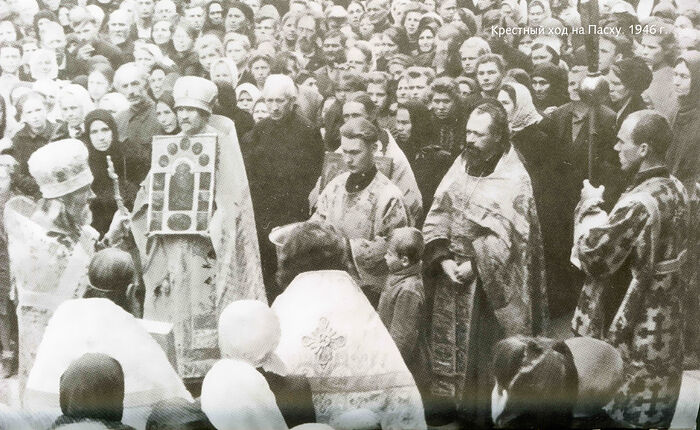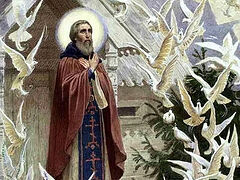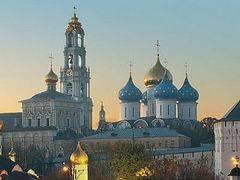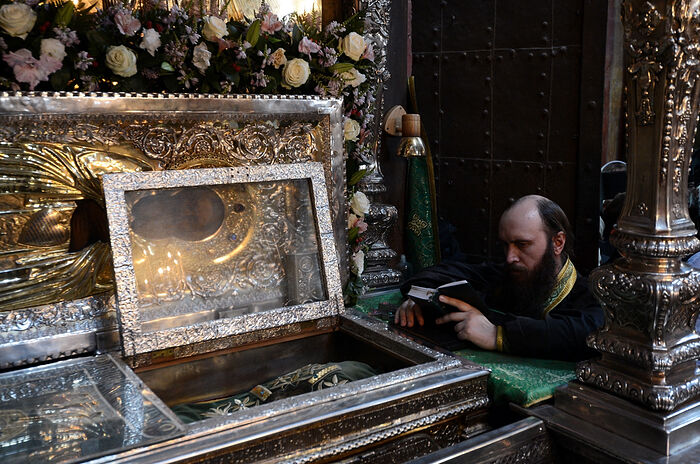 The relics of St. Sergius of Radonezh
The relics of St. Sergius of Radonezh
In 2022, the Orthodox Church celebrates a significant anniversary—six centuries ago, the relics of our Venerable and God-bearing Father Sergius, the Abbot of Radonezh, were uncovered. And these precious relics have their own history over the past six centuries. And as the life of St. Sergius himself was filled with sorrows, difficulties, and trials, so the history of his relics has its tragic pages which nevertheless only confirm the sanctity of the ascetic and the special grace-filled power given him from God above to strengthen, enlighten, and heal spiritual and bodily infirmities. In these holy jubilee days, I would like to recall the most vivid pages of this history.
The uncovering of the precious relics
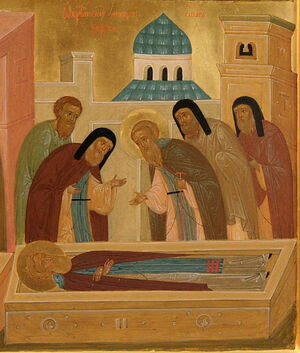 The uncovering of the relics of St. Sergius St. Sergius of Radonezh reposed on September 25, 1392. The Holy Trinity Monastery he founded in 1337 on Makovets Hill was already a spiritual center of the Russian lands by then. It operated according to a coenobitic typikon, with several wooden buildings and two churches. Before his repose, the abbot asked the brethren to bury him in the common fraternal cemetery. However, Metropolitan Cyprian of Kiev blessed otherwise, and the ascetic’s precious remains were put to rest in the monastery he built, in the wooden Holy Trinity Church. In 1408, during the invasion of the Golden Horde warlord Edigu, the church was burned down. In 1412, a new Holy Trinity Church was built, on the spot where the Holy Spirit Church stands today. It was also wooden.
The uncovering of the relics of St. Sergius St. Sergius of Radonezh reposed on September 25, 1392. The Holy Trinity Monastery he founded in 1337 on Makovets Hill was already a spiritual center of the Russian lands by then. It operated according to a coenobitic typikon, with several wooden buildings and two churches. Before his repose, the abbot asked the brethren to bury him in the common fraternal cemetery. However, Metropolitan Cyprian of Kiev blessed otherwise, and the ascetic’s precious remains were put to rest in the monastery he built, in the wooden Holy Trinity Church. In 1408, during the invasion of the Golden Horde warlord Edigu, the church was burned down. In 1412, a new Holy Trinity Church was built, on the spot where the Holy Spirit Church stands today. It was also wooden.
In 1422, thirty years after St. Sergius’ blessed repose, they started building a new stone Holy Trinity Cathedral. Before the start of construction, the saint appeared in a vision to one pious Christian and ordered him to convey to Abbot Nikon of Radonezh and the brethren the following words:
“Why have you left me for so long in the tomb, covered with dirt, in water that oppresses my body?”
And so, in the place where the Holy Trinity Cathedral is now located, his holy relics were uncovered. Not just his body, but also his clothes were completely incorrupt, although there was water all around. With a large confluence of pilgrims and clergy, in the presence of Prince Yuri Dimitrievich of Zvenigorod, on July 5, 1422, the precious remains were removed from the ground and temporarily placed in the wooden Holy Trinity Church. Upon completion of the construction of the new stone Holy Trinity Cathedral, they were moved there.
A forgotten feast—the transfer of the relics of St. Sergius to a new reliquary
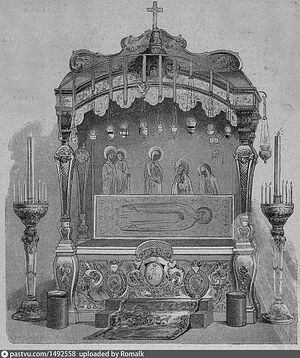 Depiction of relics of St. Sergius. St. Petersburg, 1892 The Holy Trinity Monastery was elevated in rank in the sixteenth century. The monastery cellarer Elder Adrian (Angelov) wrote a petition to Tsar Ivan the Terrible, asking him to take care of the monastery that the Most Pure Virgin herself had visited. Tsar Ivan Vasilievich didn’t leave the petition unanswered, and in 1559, he laid the foundation for the Holy Dormition Cathedral. In 1561, Elder Elevthery became the first archimandrite,1 and the monastery received the status of the main monastery of the Russian Church.
Depiction of relics of St. Sergius. St. Petersburg, 1892 The Holy Trinity Monastery was elevated in rank in the sixteenth century. The monastery cellarer Elder Adrian (Angelov) wrote a petition to Tsar Ivan the Terrible, asking him to take care of the monastery that the Most Pure Virgin herself had visited. Tsar Ivan Vasilievich didn’t leave the petition unanswered, and in 1559, he laid the foundation for the Holy Dormition Cathedral. In 1561, Elder Elevthery became the first archimandrite,1 and the monastery received the status of the main monastery of the Russian Church.
Tsar Ivan the Terrible’s son, Feodor Ivanovich, continued his father’s good initiative. During his reign, reliquaries were prepared for several revered Russian saints.
By the command of the pious Tsar … Feodor Ivanovich … and by his sincere faith and warm tears, highly valuable silver reliquaries were designed and forged for the great lamps, the pillars of the Russian land Peter and Alexei, Jonah and Paphnuty, and Sergius, and Cyril of White Lake, and Makary of Kalyazin, and Basil the Blessed. And their relics were transferred with great fear and trembling.2
Thus, a new silver reliquary was made for the relics of St. Sergius,3
and this reliquary was made in July of the year 7093 (1585), on the twenty-fifth day, by command of his son, the Tsar and Grand Prince Feodor Ivanovich, the autocrat of all Russia, and his Tsaritsa the Grand Duchess Irina, in the second year of his reign.4
In connection with the transfer of the holy relics of the founder of the monastery, a special service was composed for this solemn event, which was celebrated on this day in the Holy Trinity Cathedral in the seventeenth century.
Fire and reconstruction: How St. Sergius’ relics left Holy Trinity Cathedral
The holy relics of St. Sergius very rarely left the walls of Holy Trinity Cathedral. It’s known that they were taken out to Krasnogorsk Square during a fire in 1709. A chapel was later built on this spot, across from the Holy Gates. E. E. Golubinsky wrote about this chapel:
The chapel, located on the square near the Moscow-Yaroslavl Highway, was erected on the occasion that in 1709, during a fire in the Lavra, the relics of St. Sergius were carried out to the place where it is now. Until 1770, it was made of wood, and then it was built of stone. In 1781, an iconostasis was built in it, which has recently been replaced with a new one.5
This chapel is now called Krasnogorsk, after the name of the square.
The journals of the Moscow Theological Academy Professor Alexander Belyaev talk about how the precious relics of the saint were transferred from Holy Trinity Cathedral to Holy Dormition Cathedral in 1905:
They brought the relics of St. Sergius out of Holy Trinity Cathedral before the liturgy and carried them around Holy Dormition Cathedral with banners and icons. Evdokim and the Lavra clergy placed them in a prepared place under a canopy, between the two right columns. All the shops were locked during the transfer. Earlier, Metropolitans Ioanniky and Leonty wanted to move them to Holy Dormition Cathedral for the summer, but for some reason Pobedonostsev6 was against it. He’s agreed now, because repairs are still underway in Holy Trinity Cathedral.7
The much-suffering twentieth century
The twentieth century, as we know, was marked by the severe persecution of the Russian Orthodox Church, and the Holy Trinity-St. Sergius Lavra didn’t escape the sad fate that befell many monasteries and churches in those terrible years.
Persecution of the Church in all its various forms began to manifest itself from the first days of Soviet power. In the fall of 1918, they started confiscating the Lavra’s property. Slanderous and blasphemous articles about the monastery, about the relics of St. Sergius and the possibility of opening them began to appear in the local newspaper, “Labor Week.” During Great Lent in 1919, a large gathering of believers took place in the Trapeza Church to discuss this. Archimandrite Kronid (Lyubimov), the Lavra’s last abbot before its closure in 1920, gave a speech in which he called on the faithful to defend the holy place from desecration. Soon after that, they started collecting signatures in the churches of the Lavra, in the Academy church, and in the parish churches of Sergiev Posad for a petition to the Council of People’s Commissars not to open the relics of St. Sergius. On March 4, 1919, the brethren of the monastery, headed by Fr. Kronid, appealed to Lenin, the chairman of the Council of People’s Commissars, with a request to prohibit the opening of St. Sergius’ reliquary. On March 20, His Holiness Patriarch Tikhon also addressed Lenin about the campaign to open the relics. But despite the petitions of the faithful, the decision to open the relics was made at the plenum of the local City Council on April 1, 1919, and confirmed by the Moscow Executive Committee on April 4.
The opening of St. Sergius’ relics
The opening of St. Sergius’ relics took place on April 11. Archimandrite Kronid refused to open the reliquary with his own hand, entrusting it to the dean of the Lavra Hieromonk Jonah. Fr. Kronid said he couldn’t do it out of moral sensibility, but Fr. Jonah would fulfill the order out of obedience. The opening of the relics took two hours and was captured on film (an anti-religious propaganda film was later released). After the opening, a protocol was drawn up, and the relics were stripped of their coverings and covered with glass. The authorities’ plan was to convince the faithful not to venerate the relics. However, the number of pilgrims who came to venerate the saint, contrary to the expectations of the authorities, only increased.
A witness of these events, S. A. Volkov recalls:
From the small chapel on the square near the Red Shopping kiosks (there’s a hunting store there now), to Holy Trinity Cathedral itself, there stretched a four-person-wide line of people wanting to venerate the relics and look at them for the first time in their lives… A host of candles flooded the reliquary with dazzling light. Among the decrepit scraps of Sergius’ last clothes lay grayish-brown bones and a well preserved skull, almost chocolate-colored, surrounded by tufts of reddish, slightly gray hair was clearly seen. Experiencing inexpressible excitement, I venerated the saint’s skull, and felt a faint but distinct fragrance of rose oil which, apparently, passed to the bones from the coverings wrapped around them.8
Describing the tragic events, Fr. Pavel Florensky testified:
There was acrid smoke in the cathedral from the magnesium flares of the photography shoot they were having. But despite the strong smell in the air, sometimes a wave of some inexplicably pleasant fragrance would blow over from the reliquary, several fathoms away, overpowering all other odors. This fragrance was enveloped by a majestic joy, where it was impossible to draw a line between actual spiritual satisfaction and a pleasant feeling. Venerating the relics, I was certain that the fragrance was coming precisely from the reliquary and was incomparably stronger there than off to the side. It’s hard to even say what it could be compared to—it was so subtle and unique.9
The closing of the Lavra
On November 10, 1919, the Sergiev Executive Committee adopted a resolution on the liquidation of the Holy Trinity-St. Sergius Lavra as a monastery. On the night of November 3, 1919, the Lavra was unexpectedly searched and the brethren were driven out beyond the walls of the monastery. Worried about the fate of St. Sergius’ relics, Fr. Pavel Florensky and Count Yuri Alexandrovich Olsufiev, a future member of the Commission for the Protection of Monuments of Art and Antiquities of the Holy Trinity-St. Sergius Lavra, with the blessing of Fr. Kronid, removed the precious head of St. Sergius, replacing it with the head of one of the Trubetskoy princes buried in the seventeenth century in the Holy Trinity Cathedral crypt. The saint’s precious head was moved to Count Olsufiev’s house. After a while, fearing arrest, the Count hid it in his garden.
On March 26, 1920, the Presidium of the Moscow Executive Committee issued its decree “On the Closure of the Holy Trinity-St. Sergius Lavra and the Transfer of the Relics of the Lavra to the Moscow Museum.” According to the decree of the Council of People’s Commissars of April 20, 1920, a history and art museum was opened in the Lavra. By decision of the Sergiev Executive Committee, on May 7, 1920, Holy Trinity Cathedral was locked and sealed, despite the fact that it had already been transferred to the People’s Commissar of Education for museum purposes. On May 10, 1920, His Holiness Patriarch Tikhon condemned the closure of the Lavra churches and the intention to remove the relics as a violation of the decree “On the Separation of Church and State.” As a result of the Patriarch’s intercession, it was allowed to open Holy Trinity Cathedral only on the feast of Pentecost. On May 30, 1920, the last service was celebrated in the Lavra and the bells rang out for the last time. The monastery was finally closed to pilgrims. But the relics of St. Sergius still remained in the Lavra.
According to the recollections of the monastery inhabitant Schema-Archimandrite Mikhail (Balaev, 1924-2009), in 1933-1934, the relics of St. Sergius were in the narthex of the Trapeza Church as a museum exhibit in a reliquary with a glass lid. Once, schoolchildren were brought from Bogorodsk to the Lavra for an excursion. Fr. Mikhail recalled how the guide rudely tapped his pointer on the glass. Then the tour group went on to the Trapeza Church, and he, left alone, crossed himself and venerated the saint’s precious relics.
War and Solikamsk
After the hardships of the first half of the twentieth century, a new catastrophe followed—the Second World War. St. Sergius’ relics and some of the especially valuable museum exhibits were evacuated to Solikamsk and remained there from July 25, 1941 to November 19, 1944. They were prepared for shipment on July 19, 1941, packed and placed in a silver reliquary, under three seals of the Zagorsk10 District Department of the NVKD. Together with other exhibits of the Zagorsk Museum, they were taken to Solikamsk by train, then by barges on the Kama River. On October 22, the cargo was handed over for safekeeping by the director of the Zagorsk Museum, Ivan Zakharovich Ptitsyn, who was accompanying it, to a representation of the Russian Museum of Solikamsk. It’s noteworthy that the Holy Trinity Cathedral—a famous architectural monument of the seventeenth century—was chosen as the repository. This vast stone unheated building was managed by the museum. It was quite tolerable in the cathedral in the summer, but in the winter, when the temperatures hit -49°, it was impossible to stay in it for more than forty minutes, even in insulated boots. The museum research staff, despite the wartime difficulties, instituted a strict order, a watch, and rounds in the repository. In November 1942, A. M. Kurbatov and N. M. Prasolov, employees of the Zagorsk Museum, were sent to Solikamsk. There they periodically checked the contents of the boxes, taking preventative measures as necessary—ventilation, drying, dusting, and so on. Thanks to this, in November 1944, the museum valuables, including the precious relics of St. Sergius, were returned by train with only minor damage to the fabric, due to the specifics of evacuation.
The mystery of St. Sergius’ head
At the start of the war, Schema-Archimandrite Hilarion (Udodov), rector of the Church of the Vladimir Icon of the Mother of God in the village of Vinogradovo (close to Dolgoprudny Station), became the secret guardian of the head of St. Sergius, earlier removed by Fr. Pavel Florensky and Count Olsufiev. He was given the relic by Pavel Golubtsov (the future Archbishop Sergei).
In 1933, when they arrested Fr. Pavel Florensky, Count Olsufiev and his wife Sophia left for Novgorod. After some time they returned, but not to Sergiev Posad, where they were forbidden to live, but to the village of Meshalovka, near Lyuberets. When a suitable opportunity presented itself, Sophia and Pavel Golubtsov snuck into the garden, where the precious head was buried, and dug it up.
“It was quite eerie when we dug it up,” Vladyka Sergius later recalled.
It was nighttime. There was a dog somewhere, and we were afraid it would wake the neighbors. We had to get it done before dawn. I carried the head in a closed shopping bag so there’d be no suspicion, and I covered it with a newspaper on top, as if there were just a cabbage in the bag. It was dawn when I got to the station, and there were no trains to Moscow yet. I went on foot to Abramtsevo or Kotkhovo, and there I got on the train. On the train, I walked up and down the cars or just stood, so as not to sit down.11
St. Sergius’ head was kept in Meshalovka for a while, and in 1938, after Count Olsufiev was arrested, Pavel Golubtsov took it to Fr. Hilarion. During the most difficult days of the battle for Moscow, the relic remained in the altar of the church, five miles from the front line.
Return to the monastery
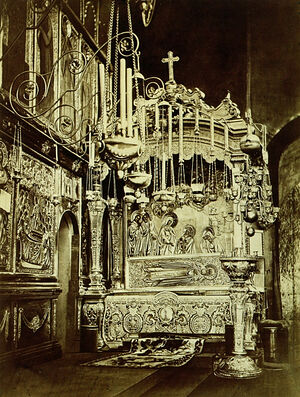 By the time the Lavra was reopened in 1946, the holy relics of St. Sergius were already in Holy Trinity Cathedral. They had returned to their historical place a year before the reopening, in January 1945. It happened just before the Local Council that took place in Moscow from January 31 to February 4. The authorities sanctioned the return in view of the expected arrival of foreign delegations who could also visit the closed Lavra. By this time, Pavel Golubstov had returned from the army. After his discharge, he took the precious head of St. Sergius from the church in Vinogradovo and gave it to Olsufiev’s heiress, his adopted daughter Ekaterina Pavlovna Vasilchikova. This was done at her request—when it became known that the Lavra was opening, Vasilchikova decided to give the relic to Patriarch Alexei I (Simansky), which was done. Having learned the secret that the precious head had been hidden in Vinogradovo, His Holiness appointed Schema-Archimandrite Hilarion (Udodov) to clothe St. Sergius’ relics, which were put in their place in Holy Trinity Cathedral, in the schema. Thus, replacing the Trubetskoy prince’s head with that of St. Sergius again also took place in the strictest secrecy, during the revesting of the relics in a new schema.
By the time the Lavra was reopened in 1946, the holy relics of St. Sergius were already in Holy Trinity Cathedral. They had returned to their historical place a year before the reopening, in January 1945. It happened just before the Local Council that took place in Moscow from January 31 to February 4. The authorities sanctioned the return in view of the expected arrival of foreign delegations who could also visit the closed Lavra. By this time, Pavel Golubstov had returned from the army. After his discharge, he took the precious head of St. Sergius from the church in Vinogradovo and gave it to Olsufiev’s heiress, his adopted daughter Ekaterina Pavlovna Vasilchikova. This was done at her request—when it became known that the Lavra was opening, Vasilchikova decided to give the relic to Patriarch Alexei I (Simansky), which was done. Having learned the secret that the precious head had been hidden in Vinogradovo, His Holiness appointed Schema-Archimandrite Hilarion (Udodov) to clothe St. Sergius’ relics, which were put in their place in Holy Trinity Cathedral, in the schema. Thus, replacing the Trubetskoy prince’s head with that of St. Sergius again also took place in the strictest secrecy, during the revesting of the relics in a new schema.
 The first Patriarchal service in the Lavra after its reopening, 1946
The first Patriarchal service in the Lavra after its reopening, 1946
The authenticity of the head is evidenced by the fact that it had a mark from the knife that Fr. Pavel Florensky used to separate it from the upper vertebra. When the saint’s head was returned, this mark matched that on the vertebra in the reliquary.
The official transfer of the relics of St. Sergius took place just before Pascha in 1946. On April 20, the first abbot of the reborn monastery Archimandrite Gury (Egorov) received the holy relics from the director of the Zagorsk Museum V. K. Ryakhovsky in a silver reliquary of the sixteenth century—the same one into which they were transferred under Tsar Feodor Ivanovich.
The opening of the Lavra in 1946 is described by Protodeacon Sergei Boskin,12 a direct participant in the event:
The Bright Resurrection of Christ, April 21. After twenty-six years of silence in the monastery of St. Sergius, the bells suddenly rang out unexpectedly on Pascha night. The people who filled the square stood with lighted candles. The procession walked freely around the cathedral and went out onto the portico. Matins began with the first “Christ is Risen.”13
“May this Pascha truly be a Pascha of deliverance from sorrow and an unceasing joy for all who come to the healing relics of St. Sergius,” wrote Patriarch Alexei I in his letter to the abbot of the Lavra.
The first Patriarchal service in the Holy Trinity-St. Sergius Lavra was held on the feast of the Holy Trinity. A temporary canopy for the holy relics of St. Sergius was built in Holy Dormition Cathedral by the right kliros. The precious relics were moved to Holy Trinity Cathedral in 1948 after their transfer to the Lavra. There they remain to this day.


